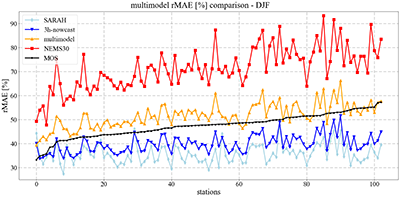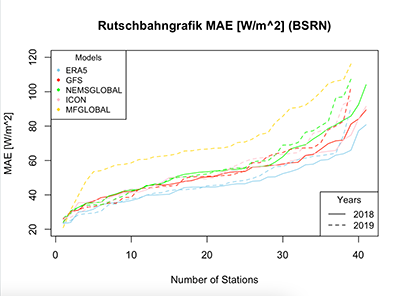- meteoblue MultiModel forecast is providing highest accuracy by combining multiple models to the best-fit forecasting.
- The best-fit forecast can be further improved with real-time updates (intraday) or by training directly on renewable energy production (MOS).
- Comparing various raw weather models, ICON and GFS show the highest performance on solar radiation forecast.
- meteoblue is constantly validating different models and methodologies to improve the forecast by including latest datasets and technologies.
- For historical time series, Satellite observations (SARAH) reaches highest accuracy, while ERA5 is useful for long term assessment and gap filling.
One of the most important sectors associated with weather forecasting is the renewable energy sector including solar power. The rapid evolving situation in the market leads to the need of precise and applicable modeling, forecasting and prediction of solar irradiance. To efficiently plan and operate solar energy systems, forecasts for up to 48 hours must be provided.
Therefore, it is of great importance to examine and compare the potential and performance of prediction models and weather forecasts. In the following we summarize findings of several studies which investigated the prediction of solar radiation as well as the performance of the (meteoblue) MultiModel and MOS approach on improving the forecast.
Latest radiation forecast improvements by meteoblue
For solar radiation and photovoltaic production forecast, meteoblue makes use of post-processing methods. In addition to simple numerical weather prediction models and multimodelling, meteoblue applies techniques like nowcasting or MOS to further improve the forecast. The following diagrams show the relative mean absolute error (rMAE) of different meteoblue datasets.
It includes post-processed forecast data of the meteoblue MultiModel (day-ahead forecast), MOS and the 3h-nowcast. Furthermore, raw model data of NEMS30 and satellite derived real time radiation data from the SARAH satellite (real-time images). For comparison, all data have been validated against hourly measurements from over 100 stations of the DWD (Deutsche Wetterdienst) from March 2022 to February 2023.
The MOS has been trained for all locations and a period of 3 years (2019-2022). The diagrams show the rMAE for each station for summer and for winter.


In both diagrams a general reduction of the prediction error up to 5 % by the MultiModel and the MOS compared to the raw model NEMS30 can be observed. Furthermore, the MOS performs even better compared to the meteoblue MultiModel. In winter, the rMAE's are in general higher since the absolute error throughout the whole year remains relatively constant but the irradiance is lower.
As the MOS training requires two way data exchange, it requires quite high efforts and is only suitable for high value renewable energy forecasting, while most use cases can be covered with the meteoblue Multilmodel.
Our current efforts to further improve the radiation forecast have shown full success. If you are interested in a direct comparison with older solar radiation forecast validations, visit our subpage Studies.
Global verification of solar radiation
Within a separate bachelor thesis (Reiss, 2021), the global incoming shortwave radiation of the weather models NEMSGLOBAL, GFS, ICON and MFGLOBAL as well as the reanalysis model ERA5 have been verified with hourly worldwide measurements of the Baseline Surface Radiation Network (BSRN) and the World Radiation Data Center (WRDC). Analysis considers the years 2018-2020 for more than 70 stations. On all measurements a quality control was applied to avoid erroneous measurements in the verification.
Raw model verification

For comparison of different raw models, the MAE was taken into consideration. The figure exemplarily shows the results of the dataset from BSRN. The model ERA5 has the lowest MAE, followed by ICON and GFS. MFGLOBAL and NEMSGLOBAL have the highest errors.
The forecast of radiation highly depends on the ability of forecast models to predict cloud schemes. Often, models over- or underestimate the radiation because these cloud schemes are not correctly predicted. ERA5 is a good example showing the advantages of post-processing methods, as it combines raw model outputs with additionally derived climatic data like measurements or satellite images.
MultiModel verification
The MultiModel approach has been tested and verified for solar radiation. For the MultiModel approach, chosen models are combined and weighted differently. The study suggests, that combining 3 or 4 models achieves the lowest errors and therefore outperforms the raw models. Also, not only the MAE was lowered, but also other statistical errors like the MBE. For more details, please have a look at the Bachelor thesis (3.5 MB).
Within each dataset, the optimal station-specific MultiModel combinations were averaged, resulting in a global MultiModel combination. With this MultiModel, the error could be lowered by up approximately 4 W/m2. The MultiModel therefore performs better that the raw models, with showing comparable results to the performance of the reanalysis model ERA5.
| BSRN 2018 | BSRN 2019 | WRDC 2018 | WRDC 2020 | ||
|---|---|---|---|---|---|
| ERA5 | 1 | 47,24 | 48,41 | 44,74 | 39,95 |
| ICON | 52,15 | 54,12 | 48,54 | 45,86 | |
| GFS | 55,72 | 56,19 | 52,85 | 47,77 | |
| MFGLOBAL | - | 78,08 | - | 56,53 | |
| NEMS | 65,48 | 65,74 | 57,68 | 54,61 | |
| MultiModel | 2 | 49,56 | 51,06 | 45,46 | 42,54 |


